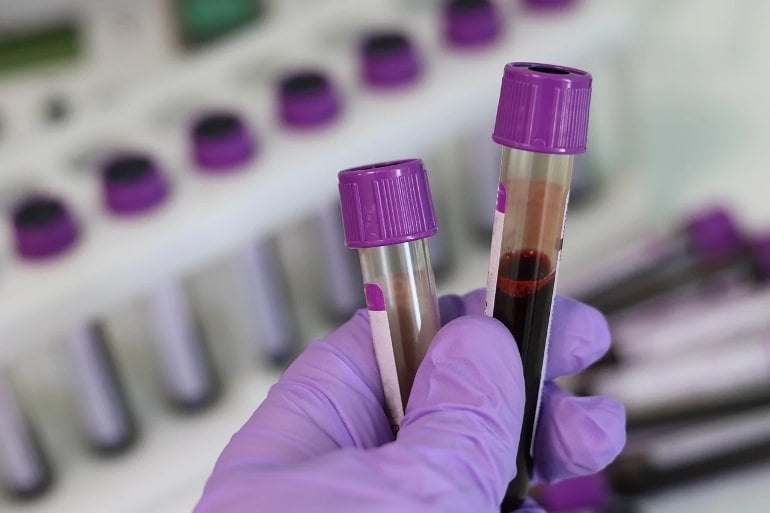Summary: Measuring blood levels of P-tau181 may allow doctors to diagnose Alzheimer’s before the onset of symptoms. Elevated levels of P-tau181 in the blood were associated with greater amyloid-beta accumulation in the brain and outperformed two other biomarkers in predicting signs of amyloid-beta in brain scans.
Source: NUI Galway
New research from NUI Galway and Boston University has identified a blood biomarker that could help identify people with the earliest signs of dementia, even before the onset of symptoms.
The study was published today (Tuesday 26 April) in the Journal of Alzheimer’s Disease.
The researchers measured blood levels of P-tau181, a marker of neurodegeneration, in 52 cognitively healthy adults, from the US-based Framingham Heart Study, who later went on to have specialised brain PET scans. The blood samples were taken from people who had no cognitive symptoms and who had normal cognitive testing at the time of blood testing.
The analysis found that elevated levels of P-tau181 in the blood were associated with greater accumulation of ß-amyloid, an abnormal protein in Alzheimer’s disease, on specialised brain scans. These scans were completed on average seven years after the blood test.
Further analysis showed the biomarker P-tau181 outperformed two other biomarkers in predicting signs of ß-amyloid on brain scans.
Emer McGrath, Associate Professor at the College of Medicine Nursing and Health Sciences at NUI Galway and Consultant Neurologist at Saolta University Health Care Group was lead author of the study.
“The results of this study are very promising – P-tau181 has the potential to help us identify individuals at high risk of dementia at a very early stage of the disease, before they develop memory difficulties or changes in behaviour,” Professor McGrath said.
The research team said the identification of a biomarker also points to the potential for a population screening program.

Professor McGrath said: “This study was carried out among people living in the community, reflecting those attending GP practices. A blood test measuring P-tau181 levels could potentially be used as a population-level screening tool for predicting risk of dementia in individuals at mid to late-life, or even earlier.
“This research also has important potential implications in the context of clinical trials. Blood levels of P-tau181 could be used to identify suitable participants for further research, including in clinical trials of new therapies for dementia.
“We could use this biomarker to identify those at a high risk of developing dementia but still at a very early stage in the disease, when there is still an opportunity to prevent the disease from progressing.”
The research was funded in Ireland by a Health Research Board Clinician Scientist Award and in the US by an Alzheimer’s Association Clinician Scientist Fellowship, the National Heart Lung and Blood Institute, the National Institute on Aging, and the National Institute of Neurological Disorders and Stroke.
About this Alzheimer’s disease research news
Author: Sheila Gorham
Source: NUI Galway
Contact: Sheila Gorham – NUI Galway
Image: The image is in the public domain
Original Research: Closed access.
“Blood Phosphorylated Tau 181 as a Biomarker for Amyloid Burden on Brain PET in Cognitively Healthy Adults” by Emer McGrath et al. Journal of Alzheimer’s Disease
Abstract
Blood Phosphorylated Tau 181 as a Biomarker for Amyloid Burden on Brain PET in Cognitively Healthy Adults
Background: Plasma phosphorylated-tau181 (p-tau181) is a promising biomarker for Alzheimer’s disease (AD) and may offer utility for predicting preclinical disease.
Objective: To evaluate the prospective association between plasma p-tau181 and amyloid-β (Aβ) and tau-PET deposition in cognitively unimpaired individuals.
Methods: Plasma p-tau181 levels were measured at baseline in 52 [48% women, mean 64.4 (SD 5.5) years] cognitively unimpaired Framingham Offspring cohort participants using samples stored between 2011–2014 who subsequently underwent 11C-Pittsburgh Compound-B (PiB)-PET and/or 18F-Flortaucipir (FTP)-PET scans (n = 18 with tau-PET) a mean of 6.8 (SD 0.6) years later. Our primary outcomes included Aβ-precuneus, Aβ-FLR (frontal, lateral, and retrosplenial cortices) and tau-global composite region PET deposition. Secondary outcomes included individual regional Aβ and tau PET-deposition. P-tau181 was compared with plasma neurofilament light chain (NFL) and glial fibrillary acidic protein (GFAP) in predicting PET outcomes.
Results: P-tau181 was associated with increased Aβ deposition in the FLR (β±SE, 1.25±0.30, p < 0.0001), precuneus (1.35±0.29, p < 0.001), and other cortical regions. Plasma NFL (1.30±0.49, p = 0.01) and GFAP (1.46±0.39, p < 0.001) were also associated with FLR Aβ deposition. In models including all three biomarkers adjusted for age, sex, APOE E4 allele, AD polygenic risk score and cortical atrophy score, p-tau181 (0.93±0.31, p < 0.01, R2 = 0.18) and GFAP (0.93±0.41, p = 0.03, R2 = 0.11), but not NFL (0.25±0.51, p = 0.62, R2 = 0.01), were associated with FLR-Aβ deposition. Plasma p-tau181 was not associated with tau-PET burden.
Conclusion: In cognitively unimpaired adults, elevated plasma p-tau181 is associated with future increased Aβ deposition across multiple brain regions. Our results highlight the potential utility of p-tau181 as a blood-biomarker to screen for brain-amyloid deposition in cognitively healthy individuals in a community-setting.






